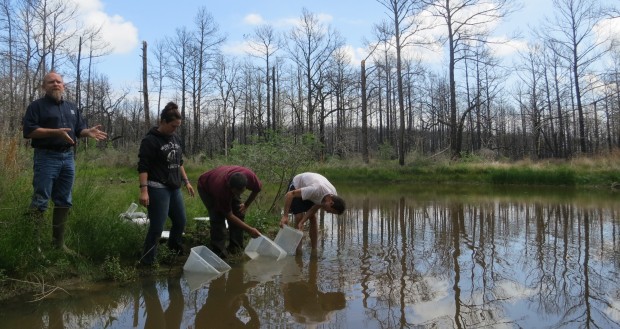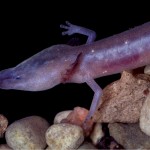Toads Gone Wild: The Promises and Pitfalls of Houston Toad Recovery

Mose Buchele
Texas Parks and Wildlife biologists and PhD students from Texas State University release Houston Toad tadpoles in Bastrop State Park. These pollywogs were not bred in captivity but were fostered in captivity from wild eggs. The burned remains of the lost pines are visible in the background.
If I had a list of terms I never expected to hear, “back up toads” would be on it.
But on Tuesday in Bastrop State Park, those three words were strung together without a hint of the absurd. Cassidy Johnson was doing the talking, and in the context of our interview, “back up toads” made a lot of sense.
Johnson is a Research Associate for the Houston Zoo‘s Houston Toad Program. The Zoo serves as what Johnson calls an “ark” for the endangered amphibians. It keeps a genetically diverse population of Houston Toads in captivity so it can maintain the species, even if every last wild toad is wiped out.

Mose Buchele
Hope for the Toads. A Houston toad pollywog set to be released into the wild. These tadpoles were fostered from eggs in an attempt to increase their survival rates.
“In case all of the Houston Toads left in Texas go extinct, they won’t honestly go extinct,” Johnson said. “We’ll still have back up toads, basically, that we can breed and release back into the wild.”
On the day I met Johnson, she was watching as thousands of toad tadpoles were released. These were collected from wild eggs and not spawned in the toad “ark.” But the Houston Zoo is also releasing adult Houston Toads it bred into property near the park this year.
“We’re hoping we’re increasing their wild survivorship. Currently, egg to adult survivorship is .01 percent,” said Melissa Jones, a Texas State PhD student in Aquatic Resources working on the Houston Toad.
“That sounds horrible,” she added with a rueful laugh.
For decades captive breeding programs like the one at the Houston Zoo have been a strategy in preserving endangered species. The National Zoo lists seven species it says have been saved from extinction through the process. The California Condor is probably the best known among them.
Despite that success, many conservationists see a downside to captive breeding.
“It’s good and bad,” said Johnson. “It’s good that we don’t let species go extinct. But it’s bad because then people don’t understand the consequences of developing an area where an endangered species is found because its like, ‘Oh they can just keep them at a zoo.'”The Houston Zoo has felt the consequence of that attitude. The adult toads the zoo released this year were actually a backlogged population. Johnson said they came from stock collected at a nearby property. But the property owners didn’t want them returned after they had been bred, due to concerns over endangered species regulations. Regulations also didn’t allow the zoo to release the toads into another area. That left them in limbo at the zoo, taking up space that was meant for younger generations.
“We were full. We didn’t have any empty tanks to put any toads,” said Robinson. “So a week and a half ago we finally got permission to release those adult toads.”
Despite her concerns that captive breeding may distract from conservation, Robinson says it’s an important strategy for the Houston Toad’s survival. It simply has less impact if not coupled with conservation. The challenge is finding landowners who will allow the toads to be transplanted back on their lands.
“We depend highly on private people to want to be interested in it,” she said. “So that’s another component of the program.”

